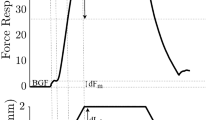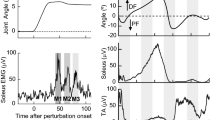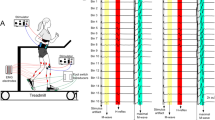Abstract
The main objective of this study was to characterize the stretch reflex response of the human thigh muscles to an unexpected knee flexion at the transition from stance to swing during walking. Eleven healthy subjects walked on a treadmill at their preferred speed. Reliable and constant knee flexions (6–12° amplitude, 230–350°/s velocity, 220 ms duration) were applied during the late swing and early stance phase of human walking by rotating the knee joint with a specifically designed portable stretch apparatus affixed to the left knee. Responses from rectus femoris (RF), vastus lateralis (VL), vastus medialis (VM), biceps femoris (BF), medial hamstrings (MH) and medial gastrocnemius (GM) were recorded via bipolar surface electromyograms (EMG). The onset of the response in the RF, VL and VM, remained stable and independent of the time in the step cycle when the stretch was applied. Across all subjects the response onset (mean ± SD) occurred at 23±1, 24±1 and 23±1 ms for RF, VL and VM, respectively. The duration of the initial response was 90–110 ms, at which time the EMG signal returned towards baseline levels. Three reflex response windows, labelled the short latency reflex (SLR), the medium latency reflex (MLR) and the late latency reflex response (LLR), were analysed. The medium and late reflex responses of all knee extensors increased significantly (p=0.008) as the gait cycle progressed from swing to stance. This was not related to the background EMG activity. In contrast, during standing at extensor EMG levels similar to those attained during walking the reflex responses were dependent on background EMG. During walking, LLR amplitudes expressed as a function of the background activity were on average two to three times greater than SLR and MLR reflex amplitudes. Distinct differences in SLR and LLR amplitude were observed for RF, VL and VM but not in the MLR amplitude. This may be related to the different pathways mediating the SLR, MLR and LLR components of the stretch response. As for the knee extensor antagonists, they exhibited a response to the stretch of the quadriceps at latencies short enough to be monosynaptic. This is in agreement with the suggestion by Eccles and Lundberg (1958) that there may be functional excitatory connections between the knee extensors and flexors in mammals.








Similar content being viewed by others
References
Andersen JB, Sinkjaer T (2003) Mobile ankle and knee perturbator. IEEE Transactions on Biomedical Engineering 50: Sept
Bayoumi A, Ashby P (1989) Projections of group Ia afferents to motoneurons of thigh muscles in man. Exp Brain Res 76:223–228
Bonnard M, Camus M, Coyle T, Pailhous J (2002) Task-induced modulation of motor evoked potentials in upper-leg muscles during human gait: a TMS study. Eur J Neurosci 16:2225–2230
Carter RR, Crago PE, Keith MW (1990) Stiffness regulation by reflex action in the normal human hand. J Neurophysiol 64:105–118
Crago PE, Houk JC, Hasan Z (1976) Regulatory actions of human stretch reflex. J Neurophysiol 39:925–935
Dietz V (1998) Evidence for a load-receptor contribution to the control of posture and locomotion. Neuroscience and Biobehavioural Reviews 22:495–499
Dietz V, Duysens J (2000) Significance of load receptor input during locomotion: a review. Gait Posture 11:102–110
Dietz V, Discher M, Faist M, Trippel M (1990a) Amplitude modulation of the human quadriceps tendon jerk reflex during gait. Exp Brain Res 82:211–213
Dietz V, Faist M, Pierrot-Deseilligny E (1990b) Amplitude modulation of the quadriceps H-reflex in the human during the early stance phase of gait. Exp Brain Res 79:221–224
Eccles RM, Lundberg A (1958) Integrative pattern of Ia synaptic actions on motoneurons of hip and knee muscles. J Physiol 144:271–298
Garland J, Gerilovsky L, Enoka R (1994) Association between muscle architecture and quadriceps femoris H-reflex. Muscle Nerve 17:581–592
Grey MJ, Ladouceur M, Andersen JB, Nielsen JB, Sinkjaer T (2001) Group II muscle afferents probably contribute to the medium latency soleus stretch reflex during walking in humans. J Physiol 534:925–933
Kearney RE, Lortie M, Stein RB (1999) Modulation of stretch reflexes during imposed walking movements of the human ankle. J Neurophysiol 81:2893–2902
Lamontagne A, Voigt M, Larsen K, Sinkjaer T (2000) Early and late components of the quadriceps stretch reflex in human. Proceedings of the Society for Neuroscience, Annual Meeting 26, p 57.1, New Orleans, USA
Lavoie BA, Devanne H, Capaday C (1997) Differential control of reciprocal inhibition during walking versus postural and voluntary motor tasks in humans. J Neurophysiol 78:429–438
Lee RG, Tatton WG (1975) Motor responses to sudden limb displacements in primates with specific CNS lesions and in human patients with motor system disorders. Can J Neurol Science 2:285–293
Leonard CT, Matsumoto T, Diedrich P (1995) Human myotatic reflex development of the lower extremities. Early Hum Dev 43:75–93
Mao CC (1984) Synaptic connections from large muscle afferents to the motoneurons of various leg muscles in man. Exp Brain Res 56:341–350
Matthews PB (1986) Observations on the automatic compensation of reflex gain on varying the pre-existing level of motor discharge in man. J Physiol 374:73–90
Morita H, Petersen N, Christensen LO, Sinkjaer T, Nielsen J (1998) Sensitivity of H-reflexes and stretch reflexes to presynaptic inhibition in humans. J Neurophysiol 80:610–620
Mrachacz-Kersting N, Sinkjaer T (2003) Reflex and non-reflex torque responses to stretch of the human knee extensors. Exp Brain Res 151:72–91
Mrachacz-Kersting N, Lavoie B, Sinkjaer T (2000) Characterization of the human quadriceps stretch reflex during human walking. Proceedings of the Society for Neuroscience, Annual Meeting 26, p 57.4, New Orleans, USA
Mrachacz-Kersting N, Grey MJ, Voigt M, Graven-Nielsen T, Sinkjaer T (2002) Does a transcortical pathway contribute to the human quadriceps stretch reflex? Proceedings of the Society for Neuroscience, Annual Meeting 32, slide No. 15.13, Orlando, USA
Nielsen JB (1998) Co-contraction of antagonistic muscles in man. Dan Med Bulletin 45:423–435
Nielsen J, Kagamihara Y (1993) The regulation of presynaptic inhibition during co-contraction of antagonistic muscles in man. J Physiol 464:575–593
Nielsen J, Kagamihara Y (1994) Synchronization of human leg motor units during co-contraction in man. Exp Brain Res 102:84–95
Petersen N, Christensen LO, Morita H, Sinkjaer T, Nielsen J (1998) Evidence that a transcortical pathway contributes to stretch reflexes in the tibialis anterior muscle in man. J Physiol 512:267–276
Schieppati M, Nardone A, Siliotto R, Grasso M (1995) Early and late stretch responses of human foot muscles induced by perturbation of stance. Exp Brain Res 105:411–422
Schillings AM, van Wezel BMH, Mulder TH, Duysens J (1999) Widespread short-latency stretch reflexes and their modulation during stumbling over obstacles. Brain Res 816:480–486
Sherrington CS (1913) On reciprocal innervation of antagonistic muscles—eighth note. Proc Royal Soc of London Series B 76(509):269–297
Sinkjaer T, Andersen JB, Larsen B (1996) Soleus stretch reflex modulation during gait in humans. J Neurophysiol 76:1112–1120
Sinkjaer T, Andersen JB, Ladouceur M, Christensen LO, Nielsen JB (2000) Major role for sensory feedback in soleus EMG activity in the stance phase of walking in man. J Physiol 523:817–827
Toft E, Sinkjaer T, Andreassen S, Larsen K (1991) Mechanical and electromyographic responses to stretch of the human ankle extensors. J Neurophysiol 65:1402–1410
Wells R, Evans N (1987) Functions and recruitment patters of one- and two-joint muscles under isometric and walking conditions. Hum Mov Sci 6:349–372
Wilmink RJH, Nichols TR (2003) Distribution of heterogenic reflexes among the quadriceps and triceps surae muscles of the cat hind limb. J Neurophys 90:2310–2324
Winter DA (1991) The biomechanics and motor control of human gait: normal, elderly and pathological. Waterloo Biomechanics, Waterloo, Canada
Yang JF, Stein RB, James KB (1991) Contribution of peripheral afferents to the activation of the soleus muscle during walking in humans. Exp Brain Res 87:679–687
Acknowledgements
The authors would like to thank The Danish National Research Foundation for their support in various aspects of the research described in this article.
Author information
Authors and Affiliations
Corresponding author
Rights and permissions
About this article
Cite this article
Mrachacz-Kersting, N., Lavoie, B.A., Andersen, J.B. et al. Characterisation of the quadriceps stretch reflex during the transition from swing to stance phase of human walking. Exp Brain Res 159, 108–122 (2004). https://doi.org/10.1007/s00221-004-1941-y
Received:
Accepted:
Published:
Issue Date:
DOI: https://doi.org/10.1007/s00221-004-1941-y




